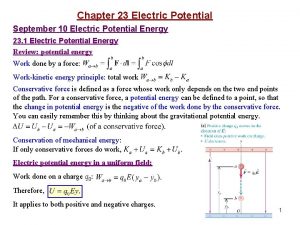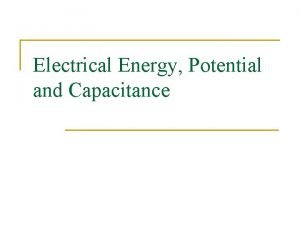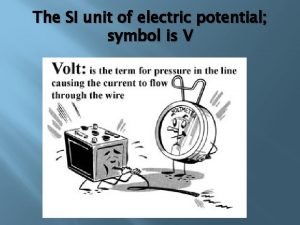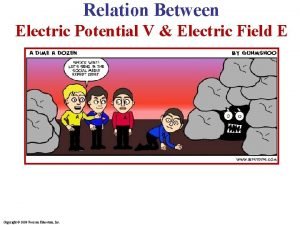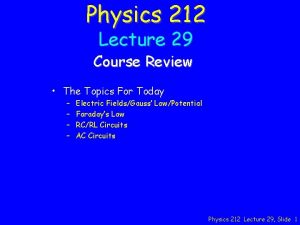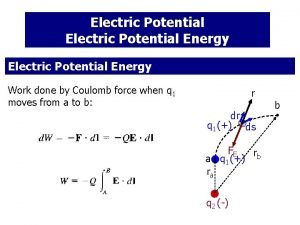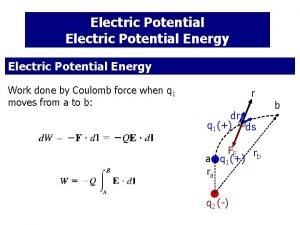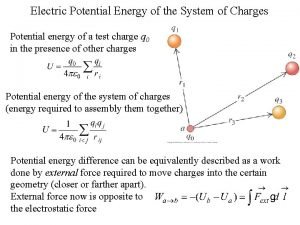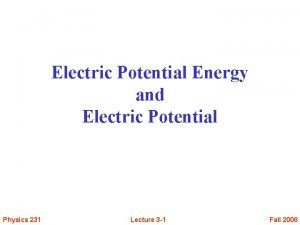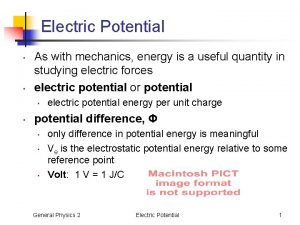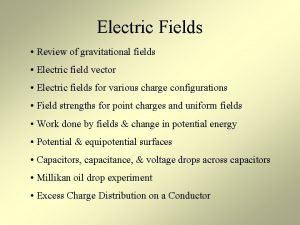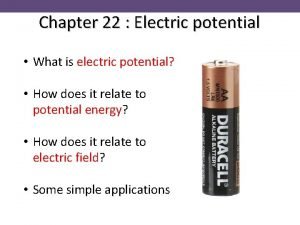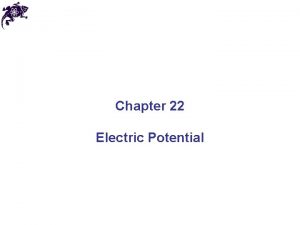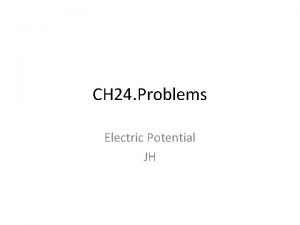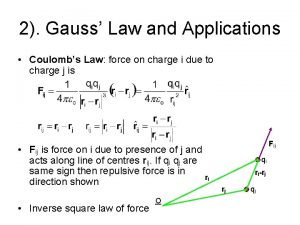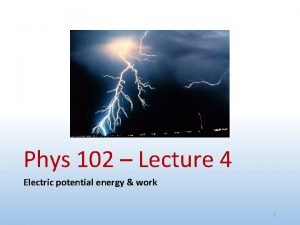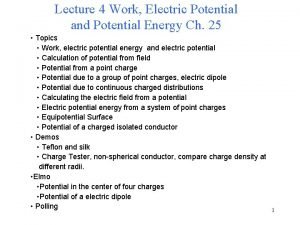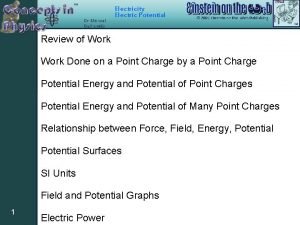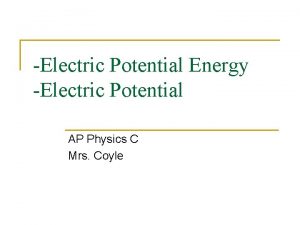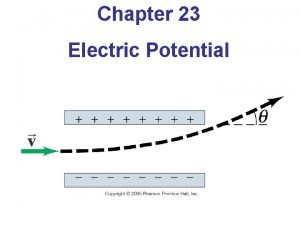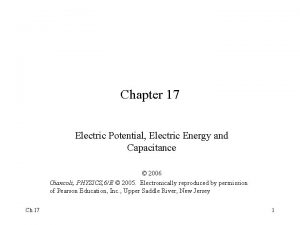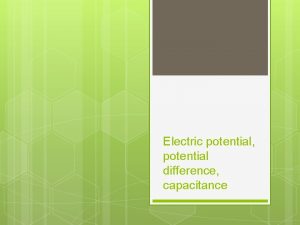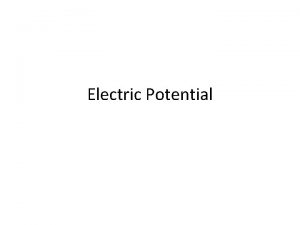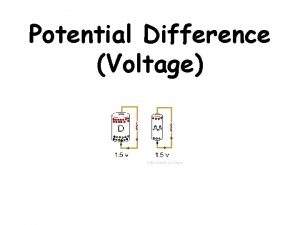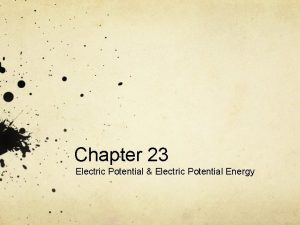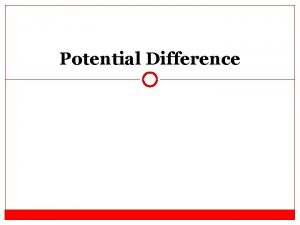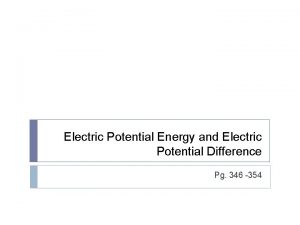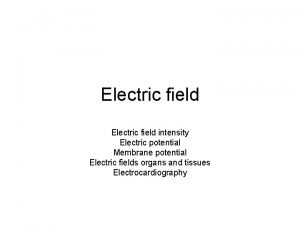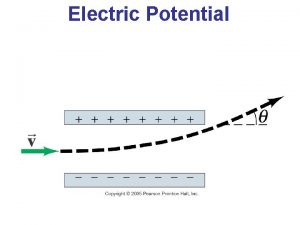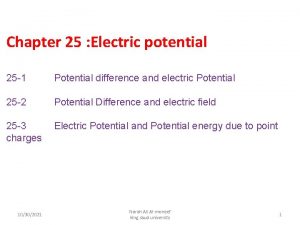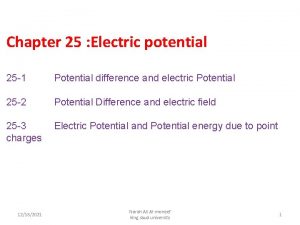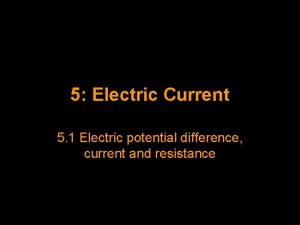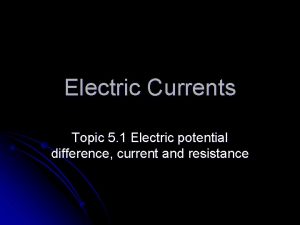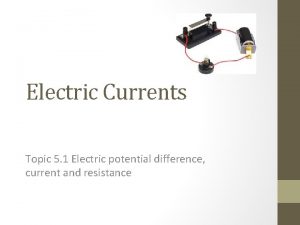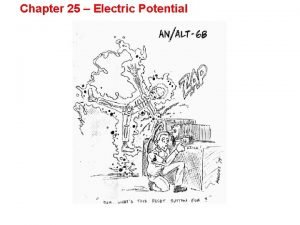Chapter 25 Electric potential 25 1 Potential Difference












































- Slides: 44

Chapter 25 Electric potential 25 -1 Potential Difference and Electric Potential. 25 -2 Potential Difference and Electric Field. 25 -3 Electric Potential and Potential Energy due to Point Charges.

Electric Potential • Electromagnetism has been connected to the study of forces in previous chapters. • In this chapter, electromagnetism will be linked to energy. • By using an energy approach, problems could be solved that were insoluble using forces. • The concept of potential energy is of great value in the study of electricity. • Because the electrostatic force is conservative, electrostatic phenomena can be conveniently described in terms of an electric potential energy. • This will enable the definition of electric potential.

Electrical Potential Energy When a test charge is placed in an electric field, it experiences a force. The force is conservative. If the test charge is moved in the field by some external agent, the work done by the field is the negative of the work done by the external agent. is an infinitesimal displacement vector that is oriented tangent to a path through space. The path may be straight or curved and the integral performed along this path is called either a path integral or a line integral.

25 -1 Potential Difference and Electric Potential

Work and Potential Energy Electric Field Definition: Work Energy Theorem a b

Electric Potential Difference a b Definition:

Conventions for the potential “zero point” “Potential” 0 0 Choice 1: Va=0 0 Choice 2: 0

25 -2 Potential Difference and electric field When a force is “conservative” ie gravitational and the electrostatic force a potential energy can be defined Change in electric potential energy is negative of work done by electric force: ∆ V = -∫ E ds = -Ed

• The change in potential energy is directly related to the change in voltage. DU = q DV DV = DU/q • DU: change in electrical potential energy (J) • q: charge moved (C) • DV: potential difference (V) • All charges will spontaneously go to lower potential energies if they are allowed to move. Units of Potential Difference Because of this, potential difference is often referred to as “voltage” In addition, 1 N/C = 1 V/m - we can interpret the electric field as a measure of the rate of change with position of the electric potential. So what is an electron Volt (e. V)?

Electron-Volts • Another unit of energy that is commonly used in atomic and nuclear physics is the electron-volt • One electron-volt is defined as the energy a charge-field system gains or loses when a charge of magnitude e (an electron or a proton) is moved through a potential difference of 1 volt 1 e. V = 1. 60 x 10 -19 J • Since all charges try to decrease UE, and DUE = q. DV, this means that spontaneous movement of charges result in negative DU. • DV = DU / q • Positive charges like to DECREASE their potential (DV < 0) • Negative charges like to INCREASE their potential. (DV > 0)

VB – VA = V C - VA VB = V C A uniform electric field directed along the positive x axis. Point B is at a lower electric potential than point A. Points B and C are at the same electric potential.

Example If a 9 V battery has a charge of 46 C how much chemical energy does the battery have? V=U/Q V=E/Q E = V x Q = 9 V x 46 C = 414 Joules

Example A pair of oppositely charged, parallel plates are separated by 5. 33 mm. A potential difference of 600 V exists between the plates. (a) What is the magnitude of the electric field strength between the plates? (b) What is the magnitude of the force on an electron between the plates?

Example Calculate the speed of a proton that is accelerated from rest through a potential difference of 120 V

25 -3 Electric Potential and Potential energy due to point charges +Q ds for a point charge

Recall the convention for the potential “zero point” Equipotential surfaces are concentric spheres

Superposition of potentials +Q 1 +Q 2 +Q 3 0

Electric Potential of a Point Charge • The electric potential in the plane around a single point charge is shown. • The red line shows the 1/r nature of the potential. Section 25. 3

Electric Potential with Multiple Charges • The electric potential due to several point charges is the sum of the potentials due to each individual charge. – This is another example of the superposition principle. – The sum is the algebraic sum • V = 0 at r = ∞ Section 25. 3

Electric Potential of a Dipole • The graph shows the potential (y-axis) of an electric dipole. • The steep slope between the charges represents the strong electric field in this region. Section 25. 3

Potential Energy of Multiple Charges • The potential energy of the system is . • If the two charges are the same sign, U is positive and work must be done to bring the charges together. • If the two charges have opposite signs, U is negative and work is done to keep the charges apart. Section 25. 3

U with Multiple Charges, final • If there are more than two charges, then find U for each pair of charges and add them. • For three charges: – The result is independent of the order of the charges. Section 25. 3

E and V for a Point Charge • The equipotential lines are the dashed blue lines • The electric field lines are the brown lines • The equipotential lines are everywhere perpendicular to the field lines An equipotential surface is a surface on which the electric potential is the same everywhere.

Figure 25. 4 (Quick Quiz 25. 3) Four equipotential surfaces Equipotential surfaces (the dashed blue lines are intersections of these surfaces with the page) and electric field lines (red- rown lines) for (a) a uniform electric field produced by an infinite sheet of charge, (b) a point charge, In all cases, the equipotential surfaces are perpendicular to the electric field lines at every point

Example (25. 1) A 12 -V battery connected to two parallel plates. The electric field between the plates has a magnitude given by the potential difference V divided by the plate separation d =0. 3 cm Example (25. 2)


Example: (a) In figure a, 12 electrons are equally spaced and fixed around a circle of radius R. Relative to V=0 at infinity, what are the electric potential and electric field at the center C of the circle due to these electrons? (b) If the electrons are moved along the circle until they are nonuniformly spaced over a 120 are (figure b), what then is the potential at C? Solution:

Potential due to a group of point charges Example (25. 3) (a) The electric potential at P due to the two charges q 1 and q 2 is the algebraic sum of the potentials due to the individual charges. (b) A third charge q 3 = 3. 00 C is brought from infinity to a position near the other charges.


Example An electric dipole consists of two charges q 1 = +12 n. C and q 2 = -12 n. C, placed 10 cm apart as shown in the figure. Compute the potential at points a, b, and c. 30

Example The Total Electric Potential At locations A and B, find the total electric potential.

(a) If two point charges are separated by a distance r 12, the potential energy of the pair of charges is given by keq 1 q 2/r 12. (b) If charge q 1 is removed, a potential keq 2/r 12 exists at point P due to charge q 2.

Potential energy due to multiple point charges +Q 2 +Q 1 +Q 3

Example 1. What is the potential energy if a +2 n. C charge moves from ¥ to point A, 8 cm away from a +6 m. C charge? The P. E. will be positive at point A, because the field can do + work if q is released. Potential Energy: A · 8 cm +Q +6 m. C U = 1. 35 m. J Positive potential energy +2 n. C

Signs for Potential Energy Consider Points A, B, and C. For +2 n. C at A: U = +1. 35 m. J Questions: If +2 n. C moves from A to B, does field E do + or – work? Does P. E. increase or decrease? A · · B 12 cm 8 cm · C +Q 4 cm +6 m. C Moving positive q +2 n. C The field E does positive work, the P. E. decreases. If +2 n. C moves from A to C (closer to +Q), the field E does negative work and P. E. increases.

Example. What is the change in potential energy if a +2 n. C charge moves from A to B? A · Potential Energy: 8 cm · 12 cm +Q From Ex-1: UA = + 1. 35 m. J DU = UB – UA = 0. 9 m. J – 1. 35 m. J Note that P. E. has decreased as work is done by E. B +6 m. C DU = -0. 450 m. J

Example What is the change in potential energy if a -2 n. C charge moves from A to B? A · Potential Energy: From Ex-1: UA = -1. 35 m. J 8 cm (Negative due to – charge) UB – UA = -0. 9 m. J – (-1. 35 m. J) A – charge moved away from a + charge gains P. E. · B 12 cm +Q +6 m. C DU = +0. 450 m. J

Example : Find the potential at a distance of 6 cm from a – 5 n. C charge. P. q = – 4 m. C r 6 cm - -Q - - Q = -5 n. C Negative V at Point P: VP = -750 V What would be the P. E. of a – 4 m. C charge placed at this point P? U = q. V = (-4 x 10 -6 m. C)(-750 V); Since P. E. is positive, E will do + work if q is released. U = 3. 00 m. J

Example : Two charges Q 1= +3 n. C and Q 2 = -5 n. C are separated by 8 cm. Calculate the electric potential at point A. B · 2 cm Q 1 + +3 n. C 6 cm A · 2 cm VA = 450 V – 2250 V; VA = -1800 V Q 2 = -5 n. C

Example Calculate the electric potential at point B for same charges. B · 2 cm Q 1 + +3 n. C 6 cm A · 2 cm VB = 1350 V – 450 V; VB = +900 V Q 2 = -5 n. C

Example : What is the potential difference between points A and B. What work is done by the E-field if a +2 m. C charge is moved from A to B? VA = -1800 V VB = +900 V VAB= VA – VB = -1800 V – 900 V VAB = -2700 V Note point B is at higher potential. Work. AB = q(VA – VB) = (2 x 10 -6 C )(-2700 V) Work = -5. 40 m. J B · Q 1 + +3 n. C 6 cm A Q 2 E-field does negative work. Thus, an external force was required to move the charge. 2 cm · - 2 cm -5 n. C

Example 6 (Cont. ): Now suppose the +2 m. C charge is moved from back from B to A? VA = -1800 V VB = +900 V VBA= VB – VA = 900 V – (-1800 V) B · Q 1 + 2 cm +3 n. C 6 cm VBA = +2700 V This path is from high to low potential. Work. BA = q(VB – VA) = (2 x Work = +5. 40 m. J 10 -6 C )(+2700 V) A Q 2 · - 2 cm -5 n. C E-field does positive work. The work is done BY the E-field this time !

Example An electron is accelerated in a TV tube through a potential difference of 5000 V. a) What is the change in PE of the electron? V = DPE/q DPE = q. V = (-1. 60 X 10 -19 C)(+5000 V)= -8. 0 X 10 -16 J What is the final speed of the electron (m = 9. 1 X 10 -31 kg) DPE + DKE = 0 (Law of conservation of energy) DPE = -DKE DPE = - ½ mv 2 = (-2)(DPE) = (-2)(-8. 0 X 10 -16 J) m 9. 1 X 10 -31 kg v = 4. 2 X 107 m/s

Summary • Electric potential energy: • Electric potential difference: work done to move charge from one point to another • Relationship between potential difference and field: • Equipotential: line or surface along which potential is the same • Electric potential of a point charge:
 Electric field lines
Electric field lines Define electric potential and potential difference.
Define electric potential and potential difference. Potential unit
Potential unit Electric potential inside non conducting sphere
Electric potential inside non conducting sphere Electric potential and potential difference
Electric potential and potential difference Electrical potential formula
Electrical potential formula Electric potential from electric field
Electric potential from electric field Pe=qed
Pe=qed Electric potential difference
Electric potential difference Chapter 21 electric charge and electric field
Chapter 21 electric charge and electric field Chapter 21 electric charge and electric field
Chapter 21 electric charge and electric field Chapter 16 electric charge and electric field
Chapter 16 electric charge and electric field Chapter 21 electric charge and electric field
Chapter 21 electric charge and electric field Market potential and forecasting
Market potential and forecasting Electric potential
Electric potential Conceptual physics chapter 33
Conceptual physics chapter 33 Chapter 23 electric potential
Chapter 23 electric potential Difference between potential difference and emf
Difference between potential difference and emf A suitable electric pump in an electric circuit is a
A suitable electric pump in an electric circuit is a Electric charges and electric forces lesson outline
Electric charges and electric forces lesson outline Symbol for electric potential energy
Symbol for electric potential energy Relationship between v and e
Relationship between v and e Electric potential inside non conducting sphere
Electric potential inside non conducting sphere Besadipol
Besadipol Gravitational potential isolines
Gravitational potential isolines Mgh gpe
Mgh gpe Coulomb force potential energy
Coulomb force potential energy Potential energy of an electric field
Potential energy of an electric field Electric potential units
Electric potential units Electric potential formula
Electric potential formula What is the potential at point a
What is the potential at point a Electrostatic energy
Electrostatic energy Electric field si units
Electric field si units Which potential graph describes this electric field
Which potential graph describes this electric field Is potential energy the integral of force
Is potential energy the integral of force Direction of electric potential
Direction of electric potential Electric potential problems and solutions
Electric potential problems and solutions Gauss law
Gauss law Can potential energy be negative
Can potential energy be negative Electric potential lecture
Electric potential lecture Electric potential to work
Electric potential to work Ap physics c electric potential
Ap physics c electric potential O que é ddp
O que é ddp Relation between potential energy and electric field
Relation between potential energy and electric field Kinetic energy electron volts
Kinetic energy electron volts
















